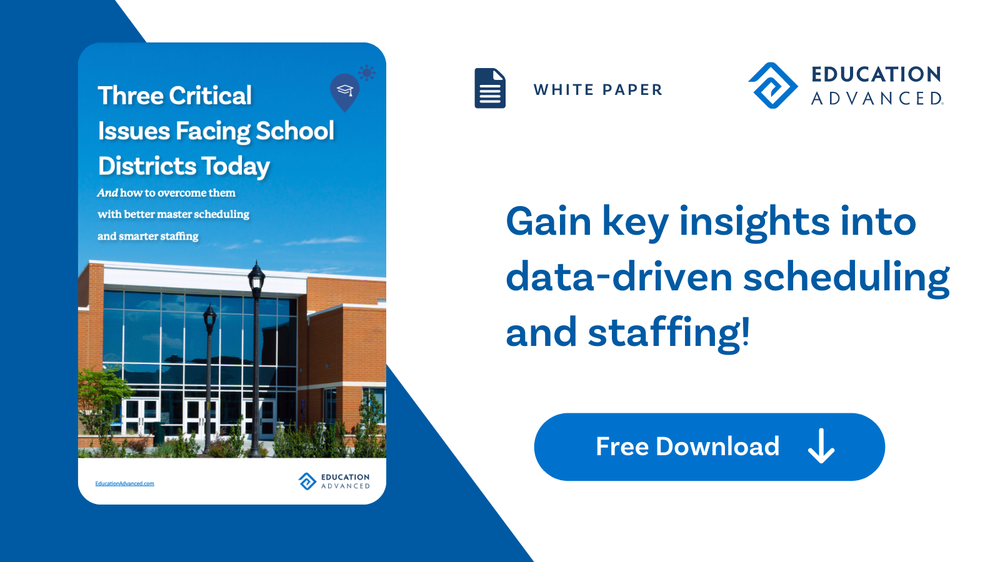Educational leaders are facing unprecedented times. These critical issues are pushing officials to make difficult decisions about teaching and learning, while leaving them wondering what the “new normal” will look like.
- Rapidly changing circumstances have forced districts to quickly transition between in-person, virtual, and hybrid learning models.
- Antiquated, inefficient processes have put a strain on already understaffed and overstretched districts.
- Higher than average staff turnover has led to disruptions in the teaching workforce and instructional continuity.
Educators across the nation are under considerable pressure to hold education standards in the face of significant resource challenges. Expectations demand that teachers, counselors, and administrators get students across the finish line with decreasing budgets, higher than normal staff turnover, rising expectations, and a rapidly changing instructional landscape. Never has it been more critical to increase efficiency to build a flexible, equitable master schedule and data-driven staffing plan to overcome resource constraints. Efficiency is a worthy imperative for every organization, especially for organizations funded by the public purse and tasked with educating our posterity.
>>> Read the full whitepaper here.
Critical Issue #1: Rapidly changing circumstances have forced districts to quickly transition between in-person, virtual, and hybrid learning models.
Building an equitable, student-driven master schedule that is flexible enough to quickly and easily transition between learning models is complex yet crucial in this multifaceted educational landscape. A school’s master schedule determines the allocation of core resources and directs the student experience. Districts locked into a singular model lack the ability to rapidly respond to change, leading to lost instructional time and diminished student achievement. A flexible master schedule gives students equal access to the courses they need and accommodates a seamless transition between multiple learning models. This move provides a higher quality, student-centered education experience, which ultimately leads to better college and career readiness.
Critical Issue #2: Antiquated, inefficient processes have put a strain on already understaffed and overstretched districts.
In a world with grand objectives and limited resources, operational efficiency is the key to maximizing productivity and success. Building a master schedule by hand is a highly inefficient labor of love that takes hundreds of hours—hours that come at a cost and the expense of other critical priorities. Streamlining and automating the master scheduling process can lead to incredible time savings for high-impact administrators and give back on opportunity tradeoffs associated with investing in building a master schedule. Following the principles of operational efficiency frees up critical resources and allows district leaders to keep an uncompromising focus on core objectives while tackling evolving needs.
Critical Issue #3 Higher than average staff turnover has led to disruptions in the teaching workforce and in instructional continuity.
The loss of high-quality teachers results in districts’ financial burdens by restaffing. Still, teacher loss’s hidden costs— costs to student achievement with the disruption of instructional continuity—come with an even higher price. Aligning staffing plans with emerging student-centered master scheduling needs facilitates equitable learning opportunities. Also, it contributes to lower student-to-teacher ratios, providing better-quality education experiences for students, and aiding in teacher retention. Connecting data-driven hiring practices to school master scheduling gives districts the flexibility to power through budget uncertainties and the roadmap to staff for the future.
The Role of Operational Efficiency in Master Scheduling
Creating an efficient master schedule is complicated and it requires school administrators to juggle the needs of the institution, staff, and students. After spending weeks coming up with a reasonably good schedule, inevitably staffing and course changes require further tweaks to the schedule or, in some cases, force administrators to completely start over. This dilemma makes organizations less adaptive to change and more willing to settle for a deficient and compromised schedule.
Operational efficiency is all about achieving output objectives with the fewest input resources possible or alternatively maximizing the output achieved on a given set of inputs. In education, districts are efficient when using their fixed budget to maximize student achievement and prepare for global competitiveness. School administrators must decide how to use their fixed resources to optimize performance against success objectives and accomplish the extraordinary task of educating youth.
The promise of technology is, and always has been, to improve efficiency by multiplying output capability. A person empowered by the right technology should accomplish more and at a higher quality level than a more expensive group of people without technology. With the right technology, you can have your cake and eat it, too.
>>> Learn more about student-centered master scheduling and data-driven staffing here.
Looking Forward
COVID-19 brought a new reality that necessitates changes to our education systems from the inside out. School officials must adjust approaches to master scheduling and staffing to make data-driven decisions about allocating limited resources. The need for greater efficiency and adaptability is imperative for school leaders making decisions for the success of future generations of students.
Change and growth are at the very core of education, and in our current circumstances we are all students. As the world braces itself for an unknown future, one thing we know for sure is that we must roll up our sleeves and work together to navigate how we will reframe education to meet the needs of our students. We will ascend again, like the phoenix, and soar to new heights as we to contribute to the rebirth of America’s education system.











